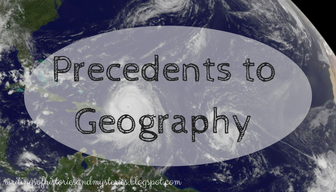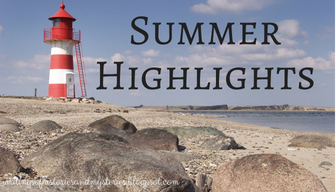Precedents to Geography ~ Part 2
Today, we will be continuing our study of Precedents to Geography. This ended up being a much longer series than I thought it would be. I am expecting to write about four parts to this series currently. Even if you have read Precedents of Geography ~ Part 1, I would advise you to go back and take a quick glance at the article to refresh your mind. And if you haven’t read the previous article for this series, you should definitely go back and take a look. I will be referring to the last article throughout this article.
In the last article, I discussed continents, oceans, resources, map projections, and coordinates. I will fill this article with the topic of weather and climate. Climate refers to the patterns of weather that change usually through the seasons. This is different than weather in that weather refers to the temperature and conditions (wind, rain, etc.). Weather is broadcasted on news channels regularly because weather changes from hour to hour. Climate is much more stable. Wind patterns, ocean currents, temperature, altitude, location, and bodies of water all affect climate.
The earth is divided into three major climate zones. The map below illustrates these zones. The Frigid or Polar Zones are located at the top and bottom of the globe. These zones are marked by the Arctic and Antarctic Circles which I discussed as lines of latitude in the previous article. The Temperate Zones are located between the Arctic Circle and the Tropic of Cancer and between the Antarctic Circle and the Tropic of Capricorn. These zones have a mild climate where it is neither too cold nor too hot. The Torrid Zones, located between the Topic of Cancer and the Tropic of Capricorn, include the equator in this region. The word “torrid” and the equator both connote heat which would be the exact word to describe the climate of this region.
Within these zones are climate classifications formulated by German climatologist and meteorologist Wladimir Köppen. He classified the world’s regions into five divisions according to its climax vegetation (the plants that live there).
- The Polar climates in the Frigid Zone include the icecap and tundra. The icecap is located in Antarctica and is frozen all year round. The tundra has a layer of permafrost (permanent frost that stays year-round) and very few trees because of these conditions. The highland, found in the mountains, is similar to the tundra except for its location. The highland is usually grouped separately from the rest of the Polar climates.
- The Continental climates are subpolar and humid continental. The subpolar is found in much of Canada and Russia. It is characterized by conifers (cone-bearing trees) and forests. This climate is still very cold, but it has some cool summers. Humid continental is found in Eastern Europe and the East Coast of the United States. These regions have less rainfall, and more vegetation.
- The Mild Climates are marine west coast, humid subtropics, and Mediterranean. Marine west coast are prosperous regions with many different types of vegetation, and frequent rainfall in each season. Humid subtropics are very similar to the marine west coast except for the fact that this climate is mostly found on the east coasts of continents rather than the west. Mediterranean climates are much more dry and warm than the other Mild Climates. They contain smaller plants and are also found primarily on the west coast of continents.
- The Tropical Climates include the savanna and the rainforest. The savannas are found in Central Africa. They abound with plants that can stand to the dry climate such as tall grasses and a few trees. The rainforest found in Northern South America, and is very hot and humid. Many trees, vines, and creatures live in the dense canopies of the forest.
- The Dry Climates include the desert and the steppe. The desert is known for losing more water through evaporation than gaining water through rainfall. These regions are very hot during the day, and fairly cold during the night. Cacti, small shrubs, and very few grasses grow here. The steppe is very similar to the desert except that it is found in regions with fairly high altitude although not as high as the highlands. Additionally more grass grows in these areas than in the desert.
These climate classifications are very similar to the major biomes that are studied in ecology. Major biomes are classified according to its climax community (plants and animals that live in a particular region) and the climate classifications stated above. The major biomes are the arctic tundra, alpine tundra, northern coniferous forest (also called the boreal forest or taiga), temperate deciduous forest, grasslands, deserts, and tropical rain forests, and aquatic biomes.
Now I will be moving onto the wind patterns before I close this article. The two major wind patterns are the trade winds and prevailing westerlies. The trade winds were named by merchants who were traveling in the 18th and 19th centuries. They used these winds as a compass to sail from Europe to America. The prevailing westerlies did the exact opposite for the sailors. They were used to navigate from the Americas to Europe.
Although I will not discuss these in depth; precipitation, elevation, and evapotranspiration (the evaporation of water from the land instead of the air) are other important factors in geography.
The verse for this week is 2 Peter 3:11-14. It says:
“Seeing then that all these things shall be dissolved, what manner of
persons ought ye to be in all holy conversation and godliness,
Looking for and hasting unto the coming of the day of God, wherein the heavens
being on fire shall be dissolved, and the elements shall melt with fervent heat?
persons ought ye to be in all holy conversation and godliness,
Looking for and hasting unto the coming of the day of God, wherein the heavens
being on fire shall be dissolved, and the elements shall melt with fervent heat?
Nevertheless we, according to his promise, look for new
heavens and a new earth, wherein dwelleth righteousness.
Wherefore, beloved, seeing that ye look for such things, be diligent
that ye may be found of him in peace, without spot, and blameless.”
heavens and a new earth, wherein dwelleth righteousness.
Wherefore, beloved, seeing that ye look for such things, be diligent
that ye may be found of him in peace, without spot, and blameless.”
This verse might seem a little dismal. After all it talks about how the earth and the heavens (referring to space, not where Christians go after death) will be destroyed. But this verse remind us that we should look forward to the new heaven and the new earth which God will create after the end of the world. It tells us that because this earth is only temporal, we should use our time to glorify Christ with our speech (“conversation”), actions, and thoughts (“godliness”). We should look forward to Christ’s return all the while being diligent in what He commanded us to do.




Comments
Post a Comment